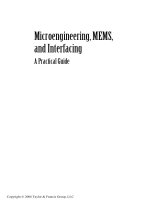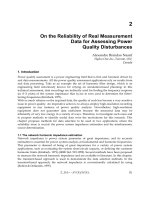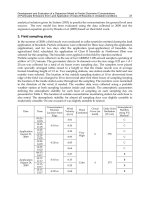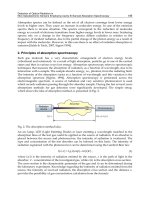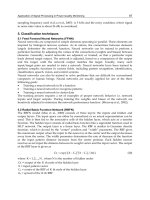Microengineering MEMs and Interfacing - Danny Banks Part 5 pot
Bạn đang xem bản rút gọn của tài liệu. Xem và tải ngay bản đầy đủ của tài liệu tại đây (1.24 MB, 17 trang )
60 Microengineering, MEMS, and Interfacing: A Practical Guide
FIGURE 2.12 KOH-etched pit and groove.
FIGURE 2.13 Illustration of how KOH etching eventually becomes limited by crystal
planes, given an arbitrary mask opening (pits viewed from above).
FIGURE 2.14 Mesa structures.
54.7°
Etch
mask
View from
above
Etch
mask
(
b
)
(a)
DK3182_C002.fm Page 60 Friday, January 13, 2006 10:58 AM
Copyright © 2006 Taylor & Francis Group, LLC
Silicon Micromachining 61
These compensation structures are designed so that they are etched away entirely
when the mesa is formed to leave 90° corners. One problem with using compen-
sation structures to form right-angled mesa corners is that they put a limit on the
minimum spacing between the mesas.
Some examples of mask designs for corner compensation structures are
shown in Figure 2.15. These are aligned with specific crystal planes and are
designed to be etched completely away when the desired KOH etch depth has
been reached. The <110> aligned structures provide almost perfect corner com-
pensation but tend to be quite large. The exact dimensions of each structure have
to be computed, based on the etching conditions experienced in the clean room.
Details are provided in papers by Puers and Sansen [6], and Sandmaier et al. [7].
The simplest structure to implement is the square corner compensation structure
(Figure 2.15a). The dimensions of this (half of one side of the square) can be
approximated by:
(2.1)
(2.2)
where h is the etching depth (height of the mesa) and the units are all in micrometers.
Equation 2.1 was derived from Puers and Sansen’s etch rates experienced with
KOH + IPA solution (IPA is isopropyl alcohol, which some find improves the
quality of KOH etches), and Equation 2.2 was derived from their results with KOH.
FIGURE 2.15 Corner compensation structures: (a) square, (b) <110> directed bar, (c) T
shapes, which may be multiplied (not to scale).
Alignment to Crystal Planes
Do not rely on flats ground onto wafers to provide alignment to crystal planes.
These are mechanically ground on and will be aligned to within a specified
tolerance error. If more precise alignment is required, then an additional mask-
ing and KOH etch step has to be introduced to etch crystal plane alignment
marks into the wafer.
x
(a) (b)
(c)
x
h
=
−133 10
4
.
x
h
=
+372 57
3
DK3182_C002.fm Page 61 Friday, January 13, 2006 10:58 AM
Copyright © 2006 Taylor & Francis Group, LLC
62 Microengineering, MEMS, and Interfacing: A Practical Guide
The silicon diaphragm is the basic structure used to construct pressure sensors
and some accelerometers. Silicon diaphragms from about 50-µm and upward thick-
nesses can be made by etching through an entire wafer with KOH (Figure 2.16).
The thickness is controlled by timing the etch and, therefore, is subject to errors
induced by variability in the composition of the etching solution, other etching
conditions, and uniformity of the wafer.
Thinner diaphragms, of up to about 20-µm thickness, can be produced using
boron to stop the KOH etch (Figure 2.17) — concentration-dependent etching.
The thickness of the diaphragm is dependent on the depth to which the boron is
diffused into the silicon, which can be controlled more accurately than the simple,
timed KOH etch.
Concentration-dependent etching can also be used to produce narrow bridges
or cantilever beams. Figure 2.18a shows a bridge, defined by a boron diffusion,
spanning a pit that was etched from the front of the wafer in KOH. A cantilever
beam (a bridge with one end free) produced by the same method is shown in
Figure 2.18b.
The bridge and beam in Figure 2.18 project across the diagonal of the pit to
ensure that they will be etched free by the KOH. More complex structures are
possible using this technique, but care must be taken to ensure that they will be
etched free by the KOH.
If it is desired to make beams or bridges of a different orientation, the wafer
can be etched through from the back in KOH (Figure 2.19). This will ensure that
the structure is released from the silicon. During such etching, it is necessary to
ensure that the front of the wafer is adequately protected from the long KOH
etch. Another alternative could be to produce a diaphragm, and etch the desired
bridge or beam shape using a reactive ion etcher (dry etching).
FIGURE 2.16 Silicon diaphragm created using a timed KOH etch (cross section, not to
scale).
FIGURE 2.17 Thin silicon diaphragm created using KOH and boron etch stop (cross
section, not to scale).
Silicon
Etch
mask
Silicon
Etch
mask
Boron
doped
silicon
DK3182_C002.fm Page 62 Friday, January 13, 2006 10:58 AM
Copyright © 2006 Taylor & Francis Group, LLC
64 Microengineering, MEMS, and Interfacing: A Practical Guide
2.7.1.3 RIE Pattern Transfer
RIE can be quite aggressive on the mask material used. Some practitioners have,
however, used this to good advantage when etching structures in silicon. If the
selectivity of silicon over oxide has been well characterized for a particular process
as 100:1, for example, then this provides a way by which the etch depth can be
carefully controlled. An oxide mask of 200-nm thickness, e.g., is deposited and
patterned on the surface of the wafer. The wafer is then etched until the oxide has
been completely removed, which should be apparent from the color of the plasma.
As a result, the pattern from the oxide mask will have been transferred into the silicon
wafer and will now be 20 µm deep due to the differing etch rates of the two materials.
2.7.1.4 Reflow
This is not, strictly speaking, a bulk micromachining technique nor is it limited
to silicon-based processes. It can be used to achieve a variety of interesting effects
such as creating smooth wavelike surfaces or spheres or for filling in around tall
structures and deep trenches. It is commonly performed with TEOS, although it
can be used with other materials including some photoresists and other polymer
films. Solder reflowing is a common procedure in many electronics processes
and can be adapted to produce interesting microstructures.
The material in question is deposited and patterned. The substrate with the
patterned material is then brought up to its melting point and the material reflows.
By controlling the timing and temperature, as well as the patterning, it is possible
to achieve a variety of effects. Stripes can be reflowed to form a more rounded
corrugated surface, isolated islands can be made to form semispherical structures
(see Figure 2.21), or trenches can be (partially) filled.
2.7.2 SURFACE MICROMACHINING
In contrast to bulk micromachining, where, as discussed in the previous section,
structures are created by removing material from the bulk of the silicon wafer or
substrate, surface micromachining involves the gradual building up and patterning
of thin films on the surface of the wafer to create the final structure. The process
would typically employ films of two different materials, a structural material
FIGURE 2.20 Formation of sharp points using a combination of RIE and wet etching:
(a) RIE pillar formed; (b) wet-etched to a point (not to scale).
Silicon
Mask
(a) (b)
DK3182_C002.fm Page 64 Friday, January 13, 2006 10:58 AM
Copyright © 2006 Taylor & Francis Group, LLC
66 Microengineering, MEMS, and Interfacing: A Practical Guide
structures have this characteristic grid pattern.) Finally comes the problem of
surface tension. Aqueous (water-based) etches, and subsequent washing in DI,
will cause the cantilever tip to bend and come into contact with the silicon wafer.
When the structure is dried, the tip will remain stuck to the wafer.
There are a number of approaches that can be taken to alleviate this problem:
substitution of the water with volatile organic compounds before drying, use of
dry etching, or critical-point drying. The simplest approach is to rinse the wafer
first in isopropyl alcohol (IPA) and then acetone, and then dry it. This is not a
particularly reliable approach, however, and acetone leaves a residue on the wafer.
(Soaking in acetone is normally used to remove resist; in this case the process is
reversed — acetone, IPA, DI — to clean the wafer.)
The use of anisotropic reactive-ion etching to release micromachined struc-
tures has become quite popular. A couple of points to note are that the RIE etch
(release) rate will depend on the lateral diffusion of the ions, so it is not partic-
ularly suited to under-etch long distances; structures released by RIE are often
more hole than structural material (i.e. lattice-like). Secondly, if long RIE times
are required, it is best to be aware that some of the structural material may be
removed as well, because etches are not perfectly selective.
The third option mentioned was the use of critical-point-drying equipment
or carbon dioxide dryers. These can be purchased as specialist units and can dry
the substrate without causing surface tension problems.
A variety of different chambers can be fabricated on the surface of silicon
wafers, using surface micromachining techniques. In Figure 2.23, the chamber
is defined by a volume of sacrificial oxide (Figure 2.23a). A layer of polysilicon
is then deposited over the surface of the wafer (Figure 2.23b). A window is dry-
etched (RIE) through the polysilicon, and the wafer is then immersed in a wet
etch that removes the oxide, leaving a windowed chamber (Figure 2.23c).
Surface micromachining can produce quite complicated structures such as
microengineered tweezers and gear trains.
Wet Etching and Micromachined Structures
Even if surface tensions are addressed, surface-micromachined structures can
be delicate to the extent that the manner in which they are withdrawn from
the final etch bath can damage them or cause sticking.
FIGURE 2.23 Forming a surface-micromachined chamber: (a) sacrificial oxide is patterned
in the shape of final chamber, (b) polysilicon is deposited, (c) polysilicon patterned to open
a hole or holes into the chamber, and the oxide is removed by wet etching (not to scale).
(a) (c)(b)
DK3182_C002.fm Page 66 Friday, January 13, 2006 10:58 AM
Copyright © 2006 Taylor & Francis Group, LLC
Silicon Micromachining 67
2.7.3 ELECTROCHEMICAL ETCHING OF SILICON
A variety of electrochemical silicon-etching techniques are under develop-
ment. One of these is the electrochemical passivation technique. A wafer with
a particular impurity concentration is used, and different impurities are diffused
(or implanted) into the wafer. This is done to form a diode junction at the boundary
between the differently doped areas of silicon; this will delineate the structure to
be produced. An electrical potential is then applied across the diode junction, and
the wafer is immersed in a suitable wet etch (KOH). This is done in such a way
that when the etch reaches the junction, an oxide layer (passivation layer) is
formed, which protects the silicon from further etching.
This is another bulk silicon micromachining technique and is essentially
similar to the boron-etch-stop technique (concentration-dependent etching). The
structures that can be produced are similar to those produced by the boron etch-
stop technique. The main advantage of the electrochemical method is that much
lower concentrations of impurities are required, and therefore the resulting struc-
ture is more compatible with the fabrication of microelectronic circuitry. It is
essential to ensure that the required electrical potential is distributed evenly across
the wafer to all necessary parts, and this may involve addition of a conducting
layer or other design considerations.
2.7.4 POROUS SILICON
Microporous silicon is created by an electrolytic process. The silicon wafer is
immersed in HF, and an electrical current is passed across the interface. Where
the silicon is exposed to both the HF and the current, a very complex (submicron)
porous structure is formed. The porosity can be controlled to some extent by
varying the parameters used.
In addition to providing an unusual structure for use in MEMS (and elec-
tronic) devices, porous silicon has a vast surface-to-volume ratio, and conse-
quently it is etched much more rapidly than normal silicon. By selectively anod-
izing different areas of the wafer (using a suitable insulating layer) and then
etching away the porous silicon, it is possible to form interesting structures.
2.7.5 WAFER BONDING
There are a number of different methods available for bonding micromachined
silicon wafers together, or to other substrates, to form larger, more complex devices.
A method of bonding silicon to glass that is particularly popular is anodic
bonding (electrostatic bonding). The silicon wafer and glass substrate are brought
together and heated to a high temperature (several hundred degrees Celsius). A large
electric field is applied across the join, which causes an extremely strong bond to
form between the two materials. This bond is formed by ions in the glass that
migrate towards the join, and there are obvious limitations on the types of glass
that can be used; in particular, the coefficient of thermal expansion has to be close
to that of silicon. Both Pyrex and borosilicate glass can be used.
DK3182_C002.fm Page 67 Friday, January 13, 2006 10:58 AM
Copyright © 2006 Taylor & Francis Group, LLC
68 Microengineering, MEMS, and Interfacing: A Practical Guide
It is also possible to bond silicon wafers directly together using gentle pressure
under water (direct silicon bonding).
Other bonding methods include using an adhesive layer, such as a spin-on-
glass or photoresist. Whereas anodic bonding and direct silicon bonding form
very strong joins, they suffer from some disadvantages, including the requirement
that the surfaces to be joined are very flat and clean. This can be overcome to
some extent by using an adhesive layer.
Figure 2.24 shows a glass plate bonded over a channel etched into a silicon
wafer (RIE), forming a pipe through which fluid can flow. Wafer-bonding tech-
niques can potentially be combined with some of the basic micromachined struc-
tures to form the valves, pumps, etc., of a microfluid-handling system.
2.8 WAFER DICING
After wire bonding and packaging, wafer dicing is one of the more expensive
processes that a device can undergo. This is because it is at this point that devices
start being handled individually, so losing some of the economy inherent in batch
production. Also, wafer dicing is often a mechanically stressful process. The three
common techniques employed to break a silicon wafer up into individual chips
or dies are as follows:
• Dicing saw
• Diamond scribe
• Laser
The wafer is normally affixed to an adhesive plastic membrane throughout
the dicing process.
2.8.1 THE DICING SAW
This is probably the most common approach to wafer dicing. A diamond saw blade
is used, and cuts of less than 100 µm can be made with 10-µm accuracy in position.
Thus, dies with dimensions of only 1 or 2 mm per side can be produced. One of
the caveats to be aware of is that because this is a process in which mechanical
force is applied to the wafer, it can damage delicate micromachined structures,
particularly surface-micromachined devices. Debris may also be deposited on the
surface of the wafer, particularly in the vicinity of the saw blade.
FIGURE 2.24 Forming a microchannel by bonding a glass plate over an etched silicon
wafer.
DK3182_C002.fm Page 68 Friday, January 13, 2006 10:58 AM
Copyright © 2006 Taylor & Francis Group, LLC
Silicon Micromachining 69
It is normal to position the saw blade in such a way that it cuts completely through
the wafer. It is possible, however, to position it so that it only cuts partway through
the wafer (several tens of micrometers). By making many such cuts, it is possible to
form trench-like or pillar-like structures, depending on the depth and spacing of the
cuts (Figure 2.25). These have been combined with wet silicon etching to produce
arrays of spikes (Figure 2.25c); the process involves repeated dipping and withdrawal
of the structure from the etch solution in order to achieve a smooth tapered point.
2.8.2 DIAMOND AND LASER SCRIBE
An alternative to using the dicing saw to break up the wafer is to break it along one
of the major crystal planes. This assumes, of course, that the individual chips have
been laid out aligned to an appropriate cleavage plane. A diamond-tipped scribe is
then drawn over the surface of the wafer to create a scratch, and flexing the wafer
causes it to break along this imperfection. Alternatively, a laser can be used to create
a series of small craters along which the wafer will be broken; this is usually
performed on the backside of the wafer to prevent ejected material and heat from
damaging the devices on the front side. Note also that silicon is transparent to infrared
light and therefore, an appropriate wavelength has to be carefully selected.
FIGURE 2.25 (a) Deep trenches can be sawn into wafers, to less than 100-µm width,
which leads to the possibility of creating microstructures, (b) sawing pillars, (c) converting
pillars to needles by wet etching.
100 µm400 µm
1 mm
1.5 mm
(a)
(c)(b)
DK3182_C002.fm Page 69 Friday, January 13, 2006 10:58 AM
Copyright © 2006 Taylor & Francis Group, LLC
70 Microengineering, MEMS, and Interfacing: A Practical Guide
2.8.3 RELEASING STRUCTURES BY KOH ETCHING
Particularly in the case of bulk micromachined structures, it is possible to consider
using anisotropic etching techniques to separate the individual dies. It is usually
a good idea to include some structures to hold the die into what remains of the
wafer until they are required, otherwise it will be necessary to fish them out from
the bottom of the etch container.
Figure 2.26 gives an example of how this may be achieved. The devices
are defined by a deep boron diffusion, and the wafer is etched from the back
in KOH to release them. Rather than etch through the entire wafer, a nitride
mask is deposited on the back of the wafer and patterned to open up windows
beneath each device. This turns the wafer into a silicon frame, and thin bridges
are formed to hold each device into the frame so that they may be broken out
as required.
FIGURE 2.26 (a) A structure or device has been defined by boron diffusion (black) into
the surface of a wafer, (b) following KOH etching of a window from the back of the wafer,
the main area of the device remains attached to a silicon frame by thin bridges that can
easily be broken.
KOH Etching through a Wafer
Depending on the thickness of the wafer, this will take some time (several
hours). Nitride is normally used as the etch mask, and only nitride and noble
metals may be exposed on the front side. Additional protection is often used.
This may take several forms such as the following:
• “Black wax” (Apiezon) usually dissolved in toluene and painted on.
It has a high melting point but many find it unsatisfactory when
used alone. It can also be difficult to remove.
• A dummy wafer taped (using PTFE) onto the front of the wafer to
be etched, often used with a layer of black wax in between.
• A specially designed jig with a seal that keeps the front of the wafer
protected from the KOH solution. Note that the front will have to
withstand short periods in KOH while the etch goes to completion.
(a) (b)
DK3182_C002.fm Page 70 Friday, January 13, 2006 10:58 AM
Copyright © 2006 Taylor & Francis Group, LLC
Silicon Micromachining 71
When using this technique (or just using KOH to etch through a wafer), it is
best to design the process so that the front side of the wafer does not have to be
protected throughout the long etching process (see box). This means that materials
unaffected by long periods on hot KOH (e.g., nitride, gold) are chosen; the bulk
of the wafer should be etched through before sensitive structures are formed on
the front. This can be done with SOI wafers.
Figure 2.27 illustrates this. The front of the wafer is protected by a PECVD
nitride layer while the KOH etch proceeds from the back through to the buried
oxide layer. The nitride layer is then stripped and material is deposited and
patterned on the front side of the wafer. Finally, RIE from the front releases the
individual devices or structures.
This is a very effective way to create and release microstructures. There are
two points to bear in mind, however. Firstly, the cavities in the back of the wafer
make it difficult for vacuum chucks to hold it in place during various processes,
notably the spin-application. Secondly, regular cavities can form lines of mecha-
nical weakness that make the wafer move susceptible to fracture during processing.
FIGURE 2.27 Use of KOH etch and SOI wafer to release free-standing microstructures
without having to worry about long exposure of the front to the etch solution: (a) SOI
wafer with PECVD nitride on the front, and nitride mask on the back, (b) etch through
to oxide etch stop, (c) stripe front nitride and oxide, and perform any additional patterning
required, (d) RIE etch to release device.
(a)
(b)
(c)
(d)
DK3182_C002.fm Page 71 Friday, January 13, 2006 10:58 AM
Copyright © 2006 Taylor & Francis Group, LLC
72 Microengineering, MEMS, and Interfacing: A Practical Guide
REFERENCES
1. Petersen, K.E., Silicon as a mechanical material, Proc. IEEE, 70(5), 420–457, 1982.
2. Vossen, J.L. and Kern, W., Eds., Thin Film Processes II, Academic Press, San
Diego, CA, 1991.
3. Williams, K.R. and Muller, R., Etch rates for micromachining processing, J.
MEMS, 5(4), 256–269, 1996.
4. Kern, W. and Deckert, C.A., Chemical etching, in Vossen, J.L. and Kern, W., Eds.,
Thin Film Processes, Academic Press, New York, 1978, chap. V-1.
5. Laermer, F. and Schilp, A., Method of Anisotropically Etching Silicon, U.S. patent
5,501,893, March 1996.
6. Puers, B. and Sansen, W., Compensation structures for convex corner microma-
chining in silicon, Sensor. Actuators, 1990, Vol. A21-23, 1036–1041.
7. Sandmaier, H., Offereins, H.L., Kühl, K., and Lang, W., Corner compensation
techniques in anisotropic etching of (100)-silicon using aqueous KOH, IEEE
Transducers ’91, 203–214, 1991.
DK3182_C002.fm Page 72 Friday, January 13, 2006 10:58 AM
Copyright © 2006 Taylor & Francis Group, LLC
73
3
Nonsilicon Processes
3.1 INTRODUCTION
There are a vast number of processes that can be used to micromachine and
microform materials other than silicon. Some of these, along with their common
applications, are introduced in this chapter. Several of them have cross over appli-
cations to silicon micromachining (electroplating, for example), and the chapter
begins with a technique that, for micromachining purposes, arose from silicon
processing and is still extensively applied in that field.
3.2 CHEMICAL–MECHANICAL POLISHING
Chemical–mechanical polishing (CMP) is one of a range of processes that are
generally used to thin and process silicon wafers (also known as
wafer lapping
).
These can be applied to a wide variety of materials and can range from pure
mechanical grinding on an abrasive wheel to CMP, which usually involves an
abrasive powder suspended in a corrosive etching solution; in design, the mechan-
ical component removes the bulk of the material and the chemical process pro-
vides a highly polished finish.
The process was originally developed and used to thin and polish silicon
wafers sliced from the ingot. In recent years it has undergone considerable
development to assist in
planarization
, a key process in producing multiple metal
interconnection layers that the modern integrated circuit industry has come to
rely on. To create structures with small feature sizes, a very flat surface is required
for photolithography and without planarization, only a few interconnection layers
(e.g., two poly and two metal) can be implemented.
The planarization process essentially involves deposition of a relatively thick
insulating layer and creation of a flat planar surface using CMP while reducing
the thickness of the film to a micron or so. The process can be used in microma-
chining, particularly where trenches or mesas cause problems with a subsequent
photolithography step. In such cases, the film thickness and structural dimensions
involved are often greater than those involved in IC fabrication, and the material
used may well be stripped later to empty the trenches.
CMP can be applied to other materials and in other forms. It is allied to the
polishing processes used to prepare geological or metallurgical samples for elec-
tron microscopy, for instance. Alternatively, an abrasive slurry can be forced
through a structure to shape and polish it.
DK3182_C003.fm Page 73 Monday, January 16, 2006 12:44 PM
Copyright © 2006 Taylor & Francis Group, LLC
74
Microengineering, MEMS, and Interfacing: A Practical Guide
3.3 LIGA AND ELECTROPLATING
The acronym LIGA comes from the German words for the process (
Lithographie,
Galvanoformung, Abformung
). LIGA uses lithography, electroplating, and mold-
ing processes to produce microstructures. It is capable of creating very finely
defined microstructures up to 1000
µ
m high. Micron feature sizes can theoretically
be implemented with aspect ratios as high as 1000:1, though achieving these in
practice depends on the processing steps that follow exposure and development.
In the process originally developed, a special kind of photolithography using
x-rays (x-ray lithography) is used to produce patterns in very thick layers of
photoresist — usually PMMA-based resists. The x-rays from a synchrotron source
are shone through a special mask onto a thick photoresist layer that covers a
conductive substrate (Figure 3.1a). This resist is then developed (Figure 3.1b). The
pattern formed is then electroplated with metal (Figure 3.1c). Nickel is commonly
used because nickel plating is a well-developed process, and reagents and equipment
are commercially available. The metal structures produced could be the final prod-
uct; however, it is common to produce a metal mold (Figure 3.1d). This mold can
then be filled with a suitable material, such as plastic (Figure 3.1e), to produce the
finished product in that material (Figure 3.1f). This process is repeated to spread
the high initial cost of masks and x-ray exposure over as many units as possible.
A plastic structure can even be electroplated to form a metal structure.
As the synchrotron source makes LIGA expensive, alternatives are being
developed. These include high-voltage electron beam lithography, which can be
used to produce structures on the order of 100
µ
m high and excimer lasers capable
of producing structures up to several hundred microns high.
FIGURE 3.1
The LIGA process: (a) x-ray exposure, (b) resist developed, (c) electroplating
to fill gaps in resist; this structure can be used as a one-off, (d) plating is continued to
create a metal mold insert, (e) injection molding, (f) final structure in plastic. The steps
illustrated in (e) and (f) may be repeated to mass produce structures.
X-rays
(a) (e)(c)
(d)(b) (f)
DK3182_C003.fm Page 74 Monday, January 16, 2006 12:44 PM
Copyright © 2006 Taylor & Francis Group, LLC
Nonsilicon Processes
75
Electroplating is not limited to use with the LIGA process but may be
combined with other processes and more conventional photolithography to pro-
duce microstructures. One aspect of the process that is very much apparent on
the microscale is its dependence on current density. The best results are obtained
if current density is constant over the entire structure, but geometrical consider-
ations mean that this is difficult to achieve. The problem is often addressed by
use of pulse electroplating (rather than constant current) and overplating. Some
LIGA processes involve overplating followed by mechanical milling to provide
a flat surface. Because this places mechanical stress on the structure, design rules
have to be employed to ensure that various parts of the structure will be suffi-
ciently supported during milling.
3.4 PHOTOCHEMICAL MACHINING
Photochemical machining (PCM) is the equivalent of silicon photolithography
and wet etching applied to metal foils. A wide variety of metal films can be
machined: steel, copper, molybdenum, etc., and these can be from tens of microns
to a few millimeters thick. The process is inherently isotropic and usually carried
out from both sides of the substrate (especially for thicker foils) in a spray-etching
system. That is, the etching solution is sprayed onto the substrate rather than
being immersed in a bath. The process is usually capable of feature sizes down
to 100
µ
m or 200
µ
m, although it may be pushed further.
PCM is commonly used in the mass production of the lead frames that are
used in IC packaging to provide electrical connections through the package to
the circuit board. If used within its normal commercial specifications and toler-
ances, this can be a very economical process compared to silicon micromachining.
By combining it with electroplating, it is possible to produce a variety of different
structures in metal, including closed channels.
3.5 LASER MACHINING
Compared to light from a conventional incandescent bulb, laser light is special:
it is monochromatic (i.e., light of only one wavelength), coherent in time and
space, and has a very low angle of divergence (i.e., it is collimated). The first
two properties make it possible to focus the entire power contained in a laser
beam onto a very small diameter spot — this results in a very high power density.
In terms of micromachining, this means that structures with vertical sidewalls
can be created in resist or very high aspect ratios can be created.
There are several different types of laser, but for micromachining purposes, only
three common types will be considered. The first two are infrared (IR) lasers,
producing IR light, and the third is the excimer laser, which produces ultraviolet
(UV) light. IR lasers are commonly used in industry and are available in laser jobbing
shops (companies that provide laser machining facilities on a sub-contract basis).
UV lasers have developed to become more specifically microengineering orientated;
one application is to produce the very-low-wavelength UV light used in DUV
photolithography.
DK3182_C003.fm Page 75 Thursday, February 2, 2006 4:24 PM
Copyright © 2006 Taylor & Francis Group, LLC
76
Microengineering, MEMS, and Interfacing: A Practical Guide
3.5.1 IR L
ASERS
There are two common IR industrial lasers — the carbon dioxide (CO
2
) lasers
and neodymium YAG (Nd:YAG) lasers. Table 3.1 summarizes some of their
properties (note that the average power is given for Nd:YAG lasers; industrial
Nd:YAG lasers are typically operated in a pulsed mode with much higher peak
power outputs).
The CO
2
laser is the most commonly available of the two, but for microma-
chining purposes, the Nd:YAG laser is most interesting. IR lasers affect materials
by localized heating. The diameter of the spot to which a laser beam can be
focused is related to the wavelength of the light, so in theory, Nd:YAG lasers can
be focused to much smaller diameters than CO
2
lasers. In practice, IR lasers are
focused to spot diameters that range from 0.03 mm to 0.3 mm.
IR lasers can be used in any of three basic applications: drilling and cutting,
welding, or heat treatment (localized hardening or annealing). Note that the
material being machined should not be too transparent or reflective for the wave-
length of light employed. Furthermore, note that when performing a process such
as cutting or welding, the material adjacent to the cut or weld will also be affected
by the heat involved in the process.
The Nd:YAG laser can produce holes of narrower diameter (down to 50-
µ
m
diameter and up to 50-mm deep) and also narrower cut (kerf) widths (down to
30
µ
m — cutting essentially proceeds by drilling a series of holes) than CO
2
lasers, which are typically operated with beam diameters of 100 to 300
µ
m. CO
2
lasers, however, are much more efficient when it comes to cutting or welding;
the Nd:YAG essentially produces very-small-diameter spot welds. IR lasers will
typically cut up to 10 mm in mild steel, less in aluminum and stainless steel, and
nonmetallic materials up to 20 mm thick.
In order to use a laser to machine a substrate, it is necessary to register the
workpiece with a reference point so that relative movement between beam and
workpiece ensures that machining occurs in the appropriate location. This is
commonly performed using a computer numerically controlled (CNC) system
(i.e., a robotic system). These are capable of considerable accuracy, and systems
developed for laser micromachining are capable of resolutions down to 2
µ
m over
an area of 200
×
200 mm.
TABLE 3.1
Laser Power Outputs
CO
2
Nd:YAG
Lasing material
Carbon dioxide, nitrogen,
and helium gas
Neodymium doped
yttrium aluminum garnet
crystal
Wavelength
10.8
µ
m 1.03
µ
m
Output power
up to 25 kW up to 1 kW
DK3182_C003.fm Page 76 Monday, January 16, 2006 12:44 PM
Copyright © 2006 Taylor & Francis Group, LLC
Nonsilicon Processes
77
3.5.2 E
XCIMER
L
ASER
M
ICROMACHINING
Excimer lasers produce relatively wide beams of UV laser light. One interesting
application of these lasers is their use in micromachining organic materials
(plastics, polymers, etc.). This is because the excimer laser does not remove
material by burning or vaporizing, unlike IR lasers, so the material adjacent to
the area machined is not melted or distorted by heating effects. The process by
which material is removed (ablated) is generally thought to be because of
interaction between the laser light and chemical bonds within the material;
individual molecules are broken up (heating involves exciting the molecules as
a whole, thus they change state from solid to gas).
When machining organic materials, the laser is operated in the pulsed mode,
removing material with each pulse. The amount of material removed is dependent
on the material itself, the length of the pulse, and the intensity (fluence) of the
laser light. Below a certain threshold fluence, depending on the material, the laser
light has no effect. As the fluence is increased above the threshold, the depth of
material removed per pulse is also increased. It is possible to accurately control
the depth of the cut by counting the number of pulses. Considerably deep cuts
(hundreds of microns) can be made using the excimer laser.
The shape of the structures produced is controlled by using chrome on quartz
masks, such as the masks produced for photolithography. In the simplest system
the mask is placed in contact with the material being machined, and the laser
light is shone through it (Figure 3.2a). A more sophisticated and versatile method
involves projecting the image of the mask onto the material (Figure 3.2b). Material
is selectively removed where the laser light strikes it.
Structures with vertical sides can be created. By adjusting the optics, it is
possible to produce structures with tapered sidewalls (Figure 3.3).
FIGURE 3.2
Schematic illustration of contact printing with (a) an excimer laser, and (b)
projection system — the substrate being machined is mounted on a computer numerically
controlled (CNC) chuck, which moves it relative to the mask plate; this enables structures
such as those in Figure 3.4 to be created with only one mask.
Laser light
Excimer laser
Mask
optics
Material being
machined
CNC chuck
(
a
)
(
b
)
DK3182_C003.fm Page 77 Monday, January 16, 2006 12:44 PM
Copyright © 2006 Taylor & Francis Group, LLC
Nonsilicon Processes
79
structures can be created by using the CNC platform to move or drag the
workpiece beneath the mask during exposure or after a set number of pulses.
Additionally, because reduction optics are commonly employed to project the
image of the mask onto the substrate, grayscale masks can be used (see Sub-
section 1.2.1, Figure 1.3) to expose different parts of the workpiece to different
intensities of laser light (the depth ablated per pulse being proportional to the
intensity).
3.6 POLYMER MICROFORMING
Polymers (plastics), in the macroworld, have the distinction of being incredibly
inexpensive to mass produce and very versatile. Many people would like to repro-
duce this success with plastic microstructures, but techniques for polymer micro-
forming lagged somewhat behind silicon and metal micromachining. The most
FIGURE 3.4
(Continued).
Extech limited
Extech limited
(c)
1 µm
200 µm
Exitech limited
Exitech limited
(d)
Smoothed
As-grown
Smoothed
200 µm
100 µm
DK3182_C003.fm Page 79 Monday, January 16, 2006 12:44 PM
Copyright © 2006 Taylor & Francis Group, LLC
